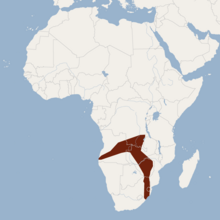| Anchieta's serotine | |
|---|---|
| Conservation status | |
 Least Concern (IUCN 3.1) | |
| Scientific classification | |
| Domain: | Eukaryota |
| Kingdom: | Animalia |
| Phylum: | Chordata |
| Class: | Mammalia |
| Order: | Chiroptera |
| Family: | Vespertilionidae |
| Genus: | Neoromicia |
| Species: | N. anchieta |
| Binomial name | |
| Neoromicia anchieta (Seabra, 1900) | |

| |
| Synonyms | |
| |
Anchieta's serotine (Neoromicia anchieta), formerly known as Anchieta's pipistrelle, is a species of vesper bat. It is found in Angola, Democratic Republic of the Congo, South Africa, Zambia, Zimbabwe and Madagascar. The species inhabits savanna habitats.
Taxonomy and etymology
It was described as a new species in 1900 by Antero Frederico de Seabra. Seabra gave it the binomial of Vesperugo anchieta. The specific epithet anchieta was emended to anchietae, which is the current specific epithet. Seabra made an error in his original spelling and corrected it in a later publication in 1900. The holotype had been collected in Cahata, Angola. The eponym for the species name "anchietae" is José Alberto de Oliveira Anchieta, a Portuguese zoologist.
It was formerly classified in the genus Pipistrellus, but phylogenetic evidence supports it belonging in the genus Neoromicia.
Description
It has a head and body length of 40 mm (1.6 in). Its ear is 11 mm (0.43 in) long; its tail is 32 mm (1.3 in) long; its forearm is 35 mm (1.4 in) long.
Range and habitat
It is found in several countries in Africa, including Angola, Democratic Republic of the Congo, South Africa, Zambia, and Zimbabwe. It has also been documented in Madagascar, though observations are rare. It is found in association with riparian habitats, as well as coastal and scrub forests. It has been documented in the Bushveld ecoregion, often near open water.
References
- ^ Monadjem, A.; Griffin, M.; Cotterill, F.; Jacobs, D.; Taylor, P.J. (2017). "Pipistrellus anchietae". IUCN Red List of Threatened Species. 2017: e.T44851A22072042. doi:10.2305/IUCN.UK.2017-2.RLTS.T44851A22072042.en.
- Kearney, Teresa C.; Volleth, Marianne; Contrafatto, Giancarlo; Taylor, Peter J. (2002). "Systematic Implications of Chromosome Gtg-Band and Bacula Morphology for Southern African Eptesicus and Pipistrellus and Several Other Species of Vespertilioninae (Chiroptera: Vespertilionidae)". Acta Chiropterologica. 4 (1): 55–76. doi:10.3161/001.004.0107.
- Kock, Dieter (2001). "Rousettus aegyptiacus (E. Geoffroy St. Hilaire, 1810) and Pipistrellus anchietae (Seabra, 1900), justified emendations of original spellings". Acta Chiropterologica. 3 (2): 245–248.
- ^ Kearney, Teresa (2013). "Pipistrellus anchietae Anchieta's Pipistrelle". In Happold, Meredith; Happold, David C. D. (eds.). Hedgehogs, Shrews and Bats. Mammals of Africa. Vol. 4. London: Bloomsbury. pp. 610–611.
- Seabra, A. F. (1900). "Diagnoses de quelques nouvelles especes et variétés de Chiropteres d'Afrique". Jornal de Sciencias, Mathematicas, Physicas e Naturaes, Lisboa. 2. 6: 120–121.
- ^ Seabra, A. D. (1900). "Sombre um caracter importante para a determinacao dos generos e especies dos microchiropteros e lista das especies d'este grupo existentes nas colleccoes do Museu Nacional". Jornal de Sciencias, Mathematicas, Physicas e Naturaes. 2. 6: 26.
- Fasel, Nicolas J; Mamba, Mnqobi L; Monadjem, Ara (2020-07-27). "Penis morphology facilitates identification of cryptic African bat species". Journal of Mammalogy. 101 (5): 1392–1399. doi:10.1093/jmammal/gyaa073. ISSN 0022-2372.
- Monadjem, Ara; Demos, Terrence C; Dalton, Desire L; Webala, Paul W; Musila, Simon; Kerbis Peterhans, Julian C; Patterson, Bruce D (2020-09-10). "A revision of pipistrelle-like bats (Mammalia: Chiroptera: Vespertilionidae) in East Africa with the description of new genera and species". Zoological Journal of the Linnean Society. 191 (4): 1114–1146. doi:10.1093/zoolinnean/zlaa087. hdl:2263/84301. ISSN 0024-4082.
- ^ Kingdon, J.; Happold, D.; Butynski, T.; Hoffmann, M.; Happold, M.; Kalina, J. (2013). Mammals of Africa. Vol. 4. A&C Black. pp. 610–611. ISBN 978-1408122549.
| Taxon identifiers | |
|---|---|
| Hypsugo anchietae | |